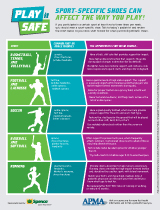Choosing Shoes for Sports
Sport-specific shoes can really affect the way you play. Make sure to have your feet professionally measured by today's podiatrist to find a correctly sized shoe. If you participate in a certain sport at least two to three times a week, you should wear a sport-specific shoe.
Avoid some serious pain and raise your game by checking out the best shoes for several sports below.
Basketball, Tennis, and Volleyball
Common foot injuries: sprains, stress fractures, tendinitis
The appropriate footwear should:
- Have a thick, stiff sole that provides support for impact.
- Have high ankle construction that supports the ankle during quick changes in direction (for basketball).
- Be lighter, have less midsole support, and contain a sole more responsive to quick starts and stops (for volleyball).
Soccer
Common foot injuries: ankle sprains, turf toe, ingrown toenails, Sever's disease
The appropriate footwear should:
- Have a good-quality footbed, which can help provide proper support for the arch and user’s foot type.
- Feature the stud type for the ground that will be played on most often: soft, hard, firm, or turf.
- Use molded rubber cleats rather than the screw-on variety.
Football and Lacrosse
Common foot injuries: turf toe, Achilles tendinitis, ankle sprains
The appropriate footwear should:
- Have a good amount of high ankle support. This support is especially important for linemen and other players who make frequent lateral movements during play.
- Allow for proper traction on a grassy field, in both wet and dry conditions.
- Never be hand-me-downs; ill-fitting cleats increase the risk of ankle injuries.
Baseball and Softball
Common foot injuries: sprains, stress fractures, plantar fasciitis, tendinitis
The appropriate footwear should:
- Offer support to prevent arch pain, which frequently affects catchers. Customized shoe inserts called orthoses may help alleviate the pain.
- Not include metal baseball spikes for athletes younger than 13.
- Try multi-cleats for children ages 11–15 to avoid heel pain.
Running
Common foot injuries: plantar fasciitis, shin splints, stress fractures, Morton's neuroma
The appropriate footwear should:
- Provide shock absorption to help runners avoid injury. Running shoes are made for high-impact forward motion and should not be used for sports with lateral movement.
- Match your foot’s arch type (high, medium, low). A podiatric physician can measure your feet and let you know what type to look for.
- Be replaced after 600–800 miles of running or walking, or every 6–8 months.
